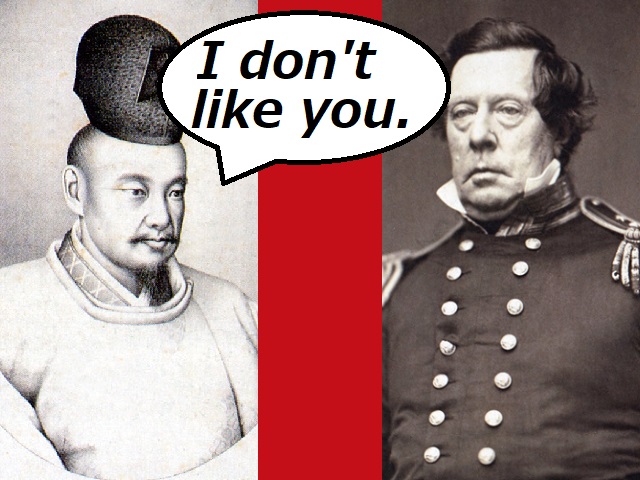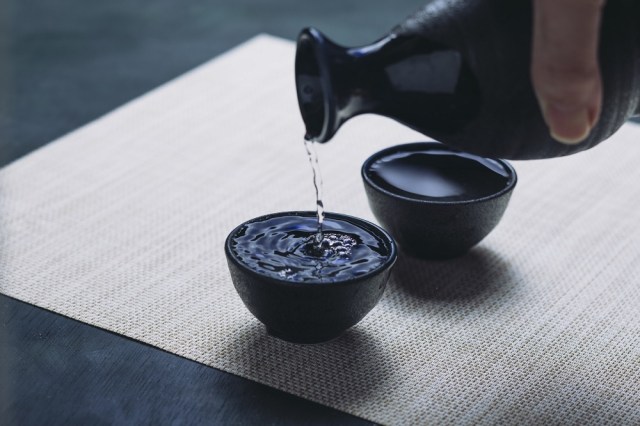
Alternate plan was to just burn them alive.
Matthew C. Perry played arguably the largest single role in ending Japan’s centuries of isolation from the rest of the world. When the U.S. commodore’s expedition arrived in Tokyo Bay in 1853, Japan had spent more than 200 years under government policies that almost entirely forbade any sort of contact with other nations, and upon his return to Japan a year later Perry and shogunate officials signed the Convention of Kanagawa, the treaty which led to the opening of Japan.
Of course, you can’t influence the abolishment of a government policy that’s been in place for so long without earning the ire of some powerful people, and recently discovered historical documents show just how displeased one samurai lord was with Perry’s presence in Japan, and even his continued existence on the planet.
Researchers recently discovered a set of 16 letters written by Tokugawa Noriaki, the daimyo of Mito Province (present-day Ibaraki Prefecture) and father of Tokugawa Yoshinobu, Japan’s final shogun. Noriaki’s letters, written between 1853 and 1855, were sent to his retainer Fujita Toko, a samurai scholar who advocated for the restoration of the emperor as the ruling figure of Japan and the expulsion of foreigners from the country.
The letters discuss specific methods for assassinating the U.S. envoys to Japan, with one section preceded by the heading “Burning the Foreigners to Death” and expanding on the subject with “If we can get them into a mansion that we’ve set up properly, we’d be able to burn them all to death at once, right?”
Another plot outlined in the letters: “Make sure their senior officers drink a lot of sake in the great hall of Edo Castle, then lop of their heads…then notify our men near Shinagawa and have them get rid of everything in their ships.”
▼ This would have trumped every “Dude, I felt so messed up after I got wasted on sake on my Tokyo trip” experience unaccustomed foreign visitors have ever told.
The letters were found in the preserved home a salt merchant in Kurashiki, Okayama Prefecture, among a collection of roughly 10,000 historical documents.
It’s worth noting that though he was the father of Japan’s last shogun, Noriaki himself never held the position and was a prominent pro-emperor figure. Though tasked for a time with advising the shogunate on matters of coastal defense, during which he was an open advocate for strengthening Japan’s military so that it could fight against foreign forces, he was also imprisoned for beefing up his personal domain’s military might against the wishes of the shogunate. As such, his personal plotting may not necessarily have aligned with the exact desires of Japan’s official government at the time.
Source: Yomiuri Shimbun via Livedoor News via Jin, Britannica
Top image: Wikipedia/GooGooDoll2, Wikipedia/Centpacrr (edited by SoraNews24)
Insert image: Pakutso
● Want to hear about SoraNews24’s latest articles as soon as they’re published? Follow us on Facebook and Twitter!
Follow Casey on Twitter, where he’s glad none of his sake sessions have ended with beheadings so far.


 Sword of one of Japan’s last samurai discovered in house in America
Sword of one of Japan’s last samurai discovered in house in America Dojigiri, the millennium-old katana said to have slain a demon, is now on display in Tokyo【Pics】
Dojigiri, the millennium-old katana said to have slain a demon, is now on display in Tokyo【Pics】 Shogun sweets? Trees said to be planted by first Tokugawa shogun still bear fruit used for sweets
Shogun sweets? Trees said to be planted by first Tokugawa shogun still bear fruit used for sweets Katana coasters! Samurai sword tableware brings bushido to your home
Katana coasters! Samurai sword tableware brings bushido to your home Pooping has never been more dramatic than it is with this Japanese toilet “sound shogun”【Video】
Pooping has never been more dramatic than it is with this Japanese toilet “sound shogun”【Video】 McDonald’s new Happy Meals offer up cute and practical Sanrio lifestyle goods
McDonald’s new Happy Meals offer up cute and practical Sanrio lifestyle goods All-you-can-drink Starbucks and amazing views part of Tokyo’s new 170 meter-high sky lounge
All-you-can-drink Starbucks and amazing views part of Tokyo’s new 170 meter-high sky lounge More foreign tourists than ever before in history visited Japan last month
More foreign tourists than ever before in history visited Japan last month Beautiful Sailor Moon manhole cover coasters being given out for free by Tokyo tourist center
Beautiful Sailor Moon manhole cover coasters being given out for free by Tokyo tourist center Mister Donut ready to make hojicha dreams come true in latest collab with Kyoto tea merchant
Mister Donut ready to make hojicha dreams come true in latest collab with Kyoto tea merchant Hamster abandoned at Tokyo ramen restaurant gets new home
Hamster abandoned at Tokyo ramen restaurant gets new home Studio Ghibli glasses cases let anime characters keep an eye on your spectacles
Studio Ghibli glasses cases let anime characters keep an eye on your spectacles Starbucks reopens at Shibuya Scramble Crossing with new look and design concept
Starbucks reopens at Shibuya Scramble Crossing with new look and design concept The oldest tunnel in Japan is believed to be haunted, and strange things happen when we go there
The oldest tunnel in Japan is believed to be haunted, and strange things happen when we go there Is the new Shinkansen Train Desk ticket worth it?
Is the new Shinkansen Train Desk ticket worth it? Disney princesses get official manga makeovers for Manga Princess Cafe opening in Tokyo
Disney princesses get official manga makeovers for Manga Princess Cafe opening in Tokyo We try out “Chan Ramen”, an underground type of ramen popular in the ramen community
We try out “Chan Ramen”, an underground type of ramen popular in the ramen community Beautiful new Final Fantasy T-shirt collection on the way from Uniqlo【Photos】
Beautiful new Final Fantasy T-shirt collection on the way from Uniqlo【Photos】 Foreign English teachers in Japan pick their favorite Japanese-language phrases【Survey】
Foreign English teachers in Japan pick their favorite Japanese-language phrases【Survey】 There’s a park inside Japan where you can also see Japan inside the park
There’s a park inside Japan where you can also see Japan inside the park Japanese convenience store packs a whole bento into an onigiri rice ball
Japanese convenience store packs a whole bento into an onigiri rice ball Studio Ghibli releases Kiki’s Delivery Service chocolate cake pouches in Japan
Studio Ghibli releases Kiki’s Delivery Service chocolate cake pouches in Japan Japan’s bone-breaking and record-breaking roller coaster is permanently shutting down
Japan’s bone-breaking and record-breaking roller coaster is permanently shutting down New definition of “Japanese whiskey” goes into effect to prevent fakes from fooling overseas buyers
New definition of “Japanese whiskey” goes into effect to prevent fakes from fooling overseas buyers Foreign passenger shoves conductor on one of the last full runs for Japan’s Thunderbird train
Foreign passenger shoves conductor on one of the last full runs for Japan’s Thunderbird train Our Japanese reporter visits Costco in the U.S., finds super American and very Japanese things
Our Japanese reporter visits Costco in the U.S., finds super American and very Japanese things Kyoto bans tourists from geisha alleys in Gion, with fines for those who don’t follow rules
Kyoto bans tourists from geisha alleys in Gion, with fines for those who don’t follow rules Studio Ghibli unveils Mother’s Day gift set that captures the love in My Neighbour Totoro
Studio Ghibli unveils Mother’s Day gift set that captures the love in My Neighbour Totoro Domino’s Japan now sells…pizza ears?
Domino’s Japan now sells…pizza ears? New Japanese KitKat flavour stars Sanrio characters, including Hello Kitty
New Japanese KitKat flavour stars Sanrio characters, including Hello Kitty Sales of Japan’s most convenient train ticket/shopping payment cards suspended indefinitely
Sales of Japan’s most convenient train ticket/shopping payment cards suspended indefinitely Sold-out Studio Ghibli desktop humidifiers are back so Totoro can help you through the dry season
Sold-out Studio Ghibli desktop humidifiers are back so Totoro can help you through the dry season Japanese government to make first change to romanization spelling rules since the 1950s
Japanese government to make first change to romanization spelling rules since the 1950s Ghibli founders Toshio Suzuki and Hayao Miyazaki contribute to Japanese whisky Totoro label design
Ghibli founders Toshio Suzuki and Hayao Miyazaki contribute to Japanese whisky Totoro label design Doraemon found buried at sea as scene from 1993 anime becomes real life【Photos】
Doraemon found buried at sea as scene from 1993 anime becomes real life【Photos】 Tokyo’s most famous Starbucks is closed
Tokyo’s most famous Starbucks is closed One Piece characters’ nationalities revealed, but fans have mixed opinions
One Piece characters’ nationalities revealed, but fans have mixed opinions We asked a Uniqlo employee what four things we should buy and their suggestions didn’t disappoint
We asked a Uniqlo employee what four things we should buy and their suggestions didn’t disappoint Princesses, fruits, and blacksmiths: Study reveals the 30 most unusual family names in Japan
Princesses, fruits, and blacksmiths: Study reveals the 30 most unusual family names in Japan Studio Ghibli’s new desktop Howl’s Moving Castle will take your stationery on an adventure
Studio Ghibli’s new desktop Howl’s Moving Castle will take your stationery on an adventure Photos from 140 years ago show Tokyo’s skyline was amazing long before the Skytree was ever built
Photos from 140 years ago show Tokyo’s skyline was amazing long before the Skytree was ever built Shogun arrested in Japan for being a peeping Tom
Shogun arrested in Japan for being a peeping Tom The blood-soaked meaning behind the mysterious marks on the floor at Tokyo Station【Photos】
The blood-soaked meaning behind the mysterious marks on the floor at Tokyo Station【Photos】 Scholars confirm first discovery of Japanese sword from master bladesmith Masamune in 150 years
Scholars confirm first discovery of Japanese sword from master bladesmith Masamune in 150 years Women, gamers, and foreigners all show up to be samurai for a day at Sengoku battle reenactment
Women, gamers, and foreigners all show up to be samurai for a day at Sengoku battle reenactment Champion figure skater Yuzuru Hanyu to make on-screen acting debut as samurai lord!
Champion figure skater Yuzuru Hanyu to make on-screen acting debut as samurai lord! U.S. military in Japan bulk buys Japanese scallops as China’s Japanese seafood ban continues
U.S. military in Japan bulk buys Japanese scallops as China’s Japanese seafood ban continues New capsule toy collection features military commander samurai armour from the Sengoku Period
New capsule toy collection features military commander samurai armour from the Sengoku Period Amazing exhibition of Japan’s legendary “cursed katana” is going on right now【Photos】
Amazing exhibition of Japan’s legendary “cursed katana” is going on right now【Photos】 Through the eyes of a ninja – Thrilling drone video recreates shinobi raid at historical temple
Through the eyes of a ninja – Thrilling drone video recreates shinobi raid at historical temple These new samurai sword scissors are gorgeous and we want them now!
These new samurai sword scissors are gorgeous and we want them now! Japan has new sake Kit Kats produced by a 393-year-old Hyogo sake brewer
Japan has new sake Kit Kats produced by a 393-year-old Hyogo sake brewer Local samurai legend is immortalized in rockin’ new short animated film by Production I.G
Local samurai legend is immortalized in rockin’ new short animated film by Production I.G Get your battle armor ready for the interactive “hottie” Samurai & Ninja Show coming to Tokyo
Get your battle armor ready for the interactive “hottie” Samurai & Ninja Show coming to Tokyo Japan ratifies child abduction treaty, but some parents may still be left behind
Japan ratifies child abduction treaty, but some parents may still be left behind
Leave a Reply